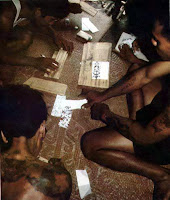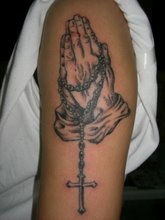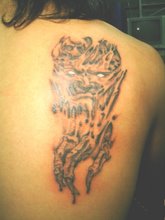 There are many ways of creating a tattoo. Some of the practices in olden days were risky, causing infections and maybe even death, but in the end the principle in making a tattoo in sterile environments is still the same: the skin is lightly pierced with one or several needles, and while the piercing takes place some type of ink is applied to the wound.
There are many ways of creating a tattoo. Some of the practices in olden days were risky, causing infections and maybe even death, but in the end the principle in making a tattoo in sterile environments is still the same: the skin is lightly pierced with one or several needles, and while the piercing takes place some type of ink is applied to the wound.
The piercing is done along the lines of the desired design, and it depends much the skills of the tattoo artist how the final result looks. In olden days the instrument to pierce was made from sharp bones, bamboo, rattan or shell, attached to a handle(woodden stick). The piercing was done using a mallet to fast and sharply hit the ‘needle’ at one end of the handle, and the simplest ink can be made very easily from soot and oil. Another local recipe (Rungus, northern Sabah) suggests pounding charcoal, mixing it with sugar cane water and straining it. A more sophisticated ink is made from boiled guava tree wood and the bark of mango tree in coconut water until black and thick. The mixture can be kept in a jar, and a few shards of iron, and tobacco may be added. This mixture is also applied to blacken teeth (Rungus, northern Sabah).
desired design, and it depends much the skills of the tattoo artist how the final result looks. In olden days the instrument to pierce was made from sharp bones, bamboo, rattan or shell, attached to a handle(woodden stick). The piercing was done using a mallet to fast and sharply hit the ‘needle’ at one end of the handle, and the simplest ink can be made very easily from soot and oil. Another local recipe (Rungus, northern Sabah) suggests pounding charcoal, mixing it with sugar cane water and straining it. A more sophisticated ink is made from boiled guava tree wood and the bark of mango tree in coconut water until black and thick. The mixture can be kept in a jar, and a few shards of iron, and tobacco may be added. This mixture is also applied to blacken teeth (Rungus, northern Sabah).
 Once the design is completed, which may be anything from a few minutes to a few hours, the wound is left to heal. Generally this should be within a few days: the skin peels off like after sunburn, and under the new skin personal body art appears…
Once the design is completed, which may be anything from a few minutes to a few hours, the wound is left to heal. Generally this should be within a few days: the skin peels off like after sunburn, and under the new skin personal body art appears…
The picture on your right is a sample of modern day tattoo machine (gun). The on the left is the usual commercial instruments whereby the one on the right is a home made machine. To Be Continued...


 Once the design is completed, which may be anything from a few minutes to a few hours, the wound is left to heal. Generally this should be within a few days: the skin peels off like after sunburn, and under the new skin personal body art appears…
Once the design is completed, which may be anything from a few minutes to a few hours, the wound is left to heal. Generally this should be within a few days: the skin peels off like after sunburn, and under the new skin personal body art appears…


